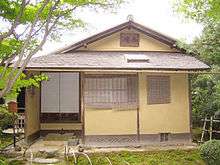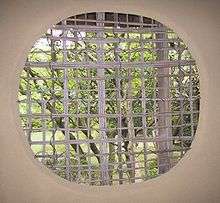Jō-an
Coordinates: 35°23′17″N 136°56′32″E / 35.38799°N 136.94235°E


Jō-an (如庵) is a seventeenth-century tea house (chashitsu). Said to be one of the three finest teahouses in the country, it was designated a National Treasure in 1951.
History
It was originally built around 1618 in Kennin-ji, Kyoto for Oda Urakusai, younger brother of Lord Oda Nobunaga and a disciple of Sen no Rikyū.[1][2] Relocated a number of times, since 1972 it has formed part of the Urakuen gardens in Inuyama.[3][4] Inuyama is part of the historic Owari Province, which the Oda clan ruled starting in the 15th century.
Architecture
Approached throughout the roji or 'dewy ground' garden, the chashitsu or tea room measures two-and-a-half tatami mats and has a three mat mizuya or preparation area. The building has a shake roof and a nijiriguchi or 'crawling-in entrance'.[1]
See also
References
- 1 2 "Database of Registered National Cultural Properties". Agency for Cultural Affairs. Retrieved 30 March 2011.
- ↑ "講談社 日本人名大辞典 - 織田有楽斎". Kodansha. Retrieved 30 March 2011.
- ↑ "Plan of Urakuen". Meitetsu Inuyama Hotel. Retrieved 30 March 2011.
- ↑ "Urakuen Japanese garden (National Treasure teahouse Joan)". Inuyama City. Retrieved 30 March 2011.
External links
![]()